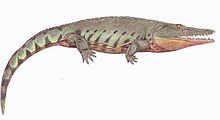| Uralerpeton Temporal range: Upper Permian, | |
|---|---|
 | |
| Uralerpeton tverdokhlebovae | |
| Scientific classification | |
| Domain: | Eukaryota |
| Kingdom: | Animalia |
| Phylum: | Chordata |
| Clade: | Reptiliomorpha (?) |
| Order: | † Chroniosuchia |
| Family: | † Chroniosuchidae |
| Genus: | † Uralerpeton Golubev, 1998 |
| Species | |
Uralerpeton is an extinct genus of chroniosuchid reptiliomorph from upper Permian (upper Tatarian age) deposits of Vladimir Region, European Russia. [1] [2] It was first named by V. K. Golubev in 1998, from skull fragments and trunk scutes. The type species is Uralerpeton tverdokhlebovae, [1] [2] it was a large predator with a 50 – 55 cm skull and a total length that probably exceeded 3 m (9.3 ft). [3]

